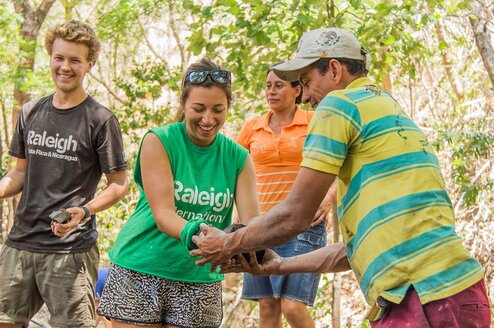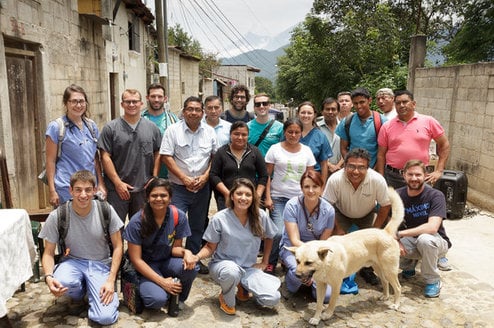Gap Year in San Jose, Costa Rica
About
Imagine living in a busy, international city but also being able to pop to the rain forest or climb an active volcano at weekends. Imagine returning home after your gap year fluent in another language and having learned to salsa like a pro. It might sound like something that’s out of reach for most people, but San José, Costa Rica, offers all of the above – and it doesn’t have to break the bank.
Relatively few people live in the city centre of this Central American capital, but morning and evening rush hours attest to just how many commute from the suburbs to work there. It can seem chaotic at first, but it’s better organized than many Latin American cities -- and safer. While English is spoken in many of tourist spots, expect to be thrown in at the deep end with your Spanish if you want to get around on your own.
A gap year in San José really is the perfect choice for many -- it offers all the convenience of living in a modern city, but it’s just a couple of hours from Costa Rica’s famous beaches, volcanoes and rain forests – pura vida!
Program Types
Choosing San José for your gap year may be a no-brainer, but picking the right kind of gap year for you might require some more thought. Perhaps the best place to start is by deciding what you want out of the experience. Some quick ideas:
- Study Spanish
- Teach English
- Volunteer (with education, helping street children, etc.)
- Work with tourism, a non-profit, or journalism
- Adventure travel
- Grad school
Most activities overlap (for example, if you volunteer you'll have opportunities to learn Spanish -- either in a class or on your own), but it’s always a good idea to have one clear goal in mind from the beginning to help you structure your gap year in San José.
If you want to learn Spanish you can find a range of language schools in Costa Rica -- such as Máximo Nivel -- which offer a range of courses that can be combined with volunteering or adventure traveling. Do note, however, that aside from a couple of nearby volcanoes, most adventure travel in Costa Rica will take you outside of San José. You should absolutely get out of the city and explore the rest of the country, but we're assuming that you're making your home base San José here.
If your focus is volunteering you should be able to find something to match your interests and skill sets, which will lead to a more rewarding experience for everyone involved. You could either aim to use a skill or qualification you already have, or learn something new as you volunteer your time and energy. Again, Go Overseas has some opportunities listed.
Costa Rica also has an active WWOOF community, with some opportunities in or nearby San José. If you're looking to stay within the city, however, you might have better luck finding a job teaching English or working in tourism.
Most English teaching jobs in San José do ask for a 6-month minimum commitment, are predominately focused on teaching business English, and the pay -- though enough to break even -- won't give you much savings. Make sure you have money saved up when you enter to travel with afterwards.
With tourism, you could do a work-exchange with a local hostel (where you work in exchange for a room / bed), or search international job boards for something more advanced. Do note, however, that most of these jobs will require you to have a higher level of Spanish, and for beginner to intermediate speakers, you're probably better off looking for volunteer work.
Planning Your Trip
Since tourism is the backbone of the Costa Rican economy, travel to and within Costa Rica tends to be pretty easy and straightforward -- which is especially nice for first time international travelers.
Literally, planning a trip to San José, Costa Rica can be as simple as booking a flight, a hostel for your first few days, and getting on. Definitely brush up on a little Spanish before you go and have some savings, but ultimately taking a gap year here takes far less planning than other destinations.
Health and Safety
Having mentioned that San José is safer than many other Latin American cities, don’t be careless. Take the same precautions you would in any big city. Ask locals about areas which might be unsafe to walk alone, particularly at night. If you don’t need your passport, don’t carry it; ditto for large amounts of cash and other valuables.
If you’re unsure, take a licensed taxi at night and avoid drawing attention to yourself and the fact that you’re from out of town. Lastly, speaking at least a basic level of Spanish will help you get around and keep safe.
Unlike several other Central American cities, there are few health concerns in San José that don't exist in the U.S. / Canada / Europe. There's no malaria. The water is potable. Pack some sunscreen and bug spray, and you'll be fine.
Visas
Visitors from the U.S. and most European countries can enter Costa Rica without a visa. You will be granted a three-month Tourist Visa on arrival, which can be renewed by leaving the country (for example crossing into Panama and returning).
Contact your nearest embassy if you wish to arrange a visa for a longer period of time or wish to work in Costa Rica. If you are traveling as part of an arranged program, the organizers should be able to give you more specific guidelines.
One thing that is strictly enforced is the rule that you will be denied entry if you do not have a valid onward ticket which shows how you will leave the country when your visa expires. If you don’t want to get a return plane ticket, a cheaper option is to purchase a bus ticket to Panama from a company such as Tica Bus.
Culture and Etiquette
Another benefit of staying in the capital city over the countryside is that you don’t have to worry as much about inadvertently offending people – they’ve seen it all before. That said, you’ll enjoy your stay and get on with the locals so much the better by being kind and polite, as you would anywhere. Ticos (Costa Ricans) are known for being warm and friendly, so a smile will go a long way. You also can’t go wrong with the local greeting - pura vida!
Taxi drivers won’t expect to be tipped, but you can for exceptional service. Tipping is the norm in most hotels and restaurants in the center. Bargaining is worth a try at markets but not in larger stores.
Costs
As mentioned in the cost of living section, there are ways that San José living can be adapted to your budget. For example, most museums charge an entry fee, but many are free on a Mondays, including the huge Museo de Arte y Diseño Contemporáneo which offers the chance to see work by domestic and international artists. Taxis seem cheap at first, but it’s worth getting to know a few key bus routes, particularly to destinations out of the city centre.
In general, cost of living in San José is similar to that of a mid-sized American city. If you're on a budget, consider doing a work exchange at one of their many hostels in exchange for free lodging. Otherwise, expect to budget at least $40 per day for the duration of your gap year -- possibly less if you intend on working (but hey, it's never a bad thing to end up with more money at the end of the trip than you planned!)
How Much Will You Spend?
For most people contemplating a gap year, this is a major consideration and while San José is cheaper than many other capitals, you’re always going to spend more in a city than in the countryside. That said, there are some obvious savings.
People living outside the capital tend to have to come in at some point and end up blowing everything they’ve saved that month on a couple of nights in a hotel and a few taxi rides. Long-term accommodation is always cheaper and language schools can often offer cheap deals and even home-stays with local families for total language immersion.
Even with volunteer programs you usually have to make some kind of contribution towards your food and accommodation. This varies from program to program and is something worth asking about early on to avoid any nasty surprises later.
If you’re not going for either of the above options, use a site such as Numbeo.com to give you an idea of what your outgoings might add up to. You’ll see that it sets the price of renting a one-bedroom apartment in the city centre at 334,000 colones (about US $626), while moving outside the centre brings it down to 284,000 colones or US $532. If that’s a little more than you were expecting, take comfort in the fact that it also indicates that a local beer costs around $2 and a one way bus ticket around 65 cents.














